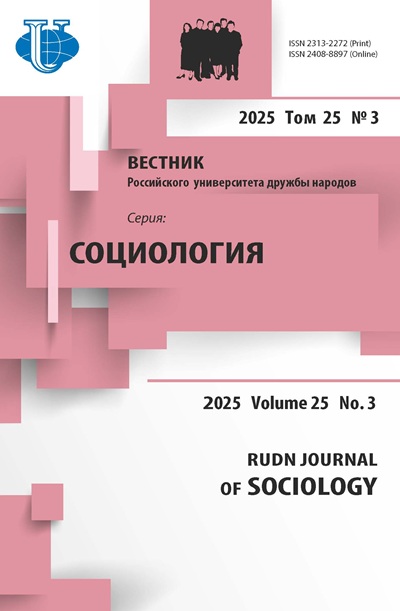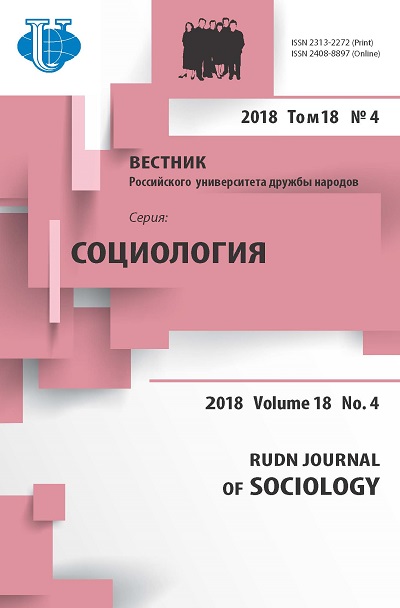ТРАНСМОБИЛЬНОСТЬ В ПОСТГУМАНИЗИРОВАННОМ МИРЕ: КАК ВСЕ ЕЩЕ ВОЗМОЖЕН СОЦИАЛЬНЫЙ ПОРЯДОК?
- Авторы: Катерный И.В.1,2
-
Учреждения:
- Московский государственный институт международных отношений (университет) МИД России
- Институт социологии ФНИСЦ РАН
- Выпуск: Том 18, № 4 (2018)
- Страницы: 638-650
- Раздел: Современное общество: актуальные проблемы и перспективы развития
- URL: https://journals.rudn.ru/sociology/article/view/19746
- DOI: https://doi.org/10.22363/2313-2272-2018-18-4-638-650
- ID: 19746
Цитировать
Полный текст
Аннотация
Одной из главных черт социальной онтологии постгуманизированного мира в ХХI веке становится распространение практик изменения, мутации и «переизобретения» социальной идентичности агентивов. Происходит снятие аскриптивных (т.е. онтологически «сильных») границ между бинарными статусными распределениями, конвенционально формировавшими гетеронормативные основания социального порядка: между человеческим и субчеловеческим (например, через легитимацию прав эмбрионов); культурным и природным (гендерные «переходы»); одушевленным и неодушевленным (через задействование гуманоидных роботов); физическим и не-физическим (через развитие технологий «дополненной реальности»). В результате образуется новая область странных и гибридных статусов и идентичностей, обладающих смесью аскриптивных и вениральных («достигаемых») характеристик. Этот процесс описывается и анализируется в статье с помощью понятия (морфологической) трансмобильности, подразумевающей как индивидуальные и независимые переходы от прошлой предписанной к новой транзитивной позиции, так и внешние переключения, ориентированные на принудительную символическую и нормативную трансформацию идентичностей как индивидуальных агентивов, так и целых групп субъектов и объектов. В статье сделан акцент на трех типических практиках трансмобильности, которые описывают природу онтологического и нормативного морфогенеза: висцеральная трансмобильность - направлена на изменение онтологии телесных аскрипций (транссексуальные переходы); конверсиональная - стирает грань между «естественной» и «искусственной» онтологией (клонирование); прозопопическая - объединяет практики переключений не-социальных созданий в активно задействованные социальные ко-агентивы (от домашних животных до роботов-андроидов). Основной вопрос статьи - как нормативный порядок сохраняется в условиях «морфологической свободы» и «плоской онтологии» постгуманизированного общества. На основе теории «борьбы за признание» автор делает вывод о существовании «морфотаксиса» - механизма воспроизводства базовой гетерономативности как основы социального порядка, который поддерживает на биологическом, когнитивном и нормативном уровнях аскриптивные различения между мужчиной и женщиной, человеком и клоном, человеком и роботом.
Ключевые слова
Об авторах
Илья Владимирович Катерный
Московский государственный институт международных отношений (университет) МИД России; Институт социологии ФНИСЦ РАН
Автор, ответственный за переписку.
Email: yarkus@mail.ru
кандидат философских наук, доцент кафедры социологии Московского государственного института международных отношений (Университета) Министерства иностранных дел России; старший научный сотрудник Института социологии Федерального научно-исследовательского социологического центра Российской академии наук
просп. Вернадского, 76, Москва, 119454, Россия; ул. Кржижановского, 24/35-5, Москва, 117218, РоссияСписок литературы
- Barrat J. Our Final Invention: Artificial Intelligence and the End of the Human Era. New York: Thomas Dunne Books/St. Martin's Press; 2013.
- Bartneck C., Kanda T., Ishiguro H., Hagita N. Is the uncanny valley an uncanny cliff? Proceedings of the 16th IEEE International Symposium on Robot and Human Interactive Communication. New York: IEEE; 2007.
- Bostrom N. In defense of posthuman dignity. Bioethics. 2005; 19 (3).
- Burleigh T.J., Schoenherr J.R., Lacroix G.L. Does the uncanny valley exist? An empirical test of the relationship between eeriness and the human likeness of digitally created faces. Computers in Human Behavior. 2013; 29 (3).
- Burnham T.C., Hare B. Engineering human cooperation. Does involuntary neural activation increase public goods contribution. Human Nature. 2007; 18 (2).
- Case M.A. Why not abolish laws of urinary segregation? Toilet: Public Restrooms and the Politics of Sharing. H. Molotch, L. Norén (Eds.). New York: New York University Press; 2010.
- Dear colleague letter on transgender students. May 13, 2016. https://www2.ed.gov/about/offices/ list/ocr/letters/colleague-201605-title-ix-transgender.pdf.
- Dieterle R.L. The Encyclopedia of Hočąk (Winnebago) Mythology. http://www.hotcakencyclopedia.com/ ho.BerdacheOriginMyth.html.
- Durkheim E. The Rules of Sociological Method. New York: The Free Press; 1982.
- Francavilla J. The concept of the divided self in Harlan Ellison’s ‘I Have No Mouth and I Must Scream’ and ‘Shatterday’. Journal of the Fantastic in the Arts. 1994; 6 (2/3).
- French A.J., Adams C.A., Anderson L.S., Kitchen J.R., Hughes M.R., Wood S.H. Development of human cloned blastocysts following somatic cell nuclear transfer with adult fibroblasts. Stem Cells. 2008; 26 (2).
- Freud S. The ‘uncanny’ (trans. by A. Strachey). The Standard Edition of the Complete Psychological Works of Sigmund Freud. Vol. XVII. An Infantile Neurosis and Other Works. J. Strachey (Ed.). London: Vintage, The Hogarth Press; 2001.
- Greely H. T. The End of Sex and the Future of Human Reproduction. Cambridge: Harvard University Press; 2016.
- Heyselaar E., Hagoor P., Segaer K. In dialogue with an avatar, language behavior is identical to dialogue with a human partner. Behavior Research Methods. 2015; 49 (1).
- Honneth A. The Struggle for Recognition. The Moral Grammar of Social Conflicts. Cambridge: MIT Press; 1996.
- Human Dignity and Human Cloning. S. Vöneky, R. Wolfrum (Eds). Leiden: Martinus Nijhoff Publishers; 2004.
- Jentsch E. On the psychology of the uncanny. Uncanny Modernity: Cultural Theories, Modern Anxieties. J. Collins, J. Jervis (Eds.). Hampshire: Palgrave Macmillan; 2008.
- Lewkowicz D.J., Ghazanfar A.A. The development of the uncanny valley in infants. Developmental Psychobiology. 2012; 54 (2).
- MacDorman K.F., Entezari S.O. Individual differences predict sensitivity to the uncanny valley. Interaction Studies. 2015;16 (2).
- Matsuda Y.T., Okamoto Y., Ida M., Okanoya K., Myowa-Yamakoshi M. Infants prefer the faces of strangers or mothers to morphed faces: The uncanny valley between social novelty and familiarity. Biology Letters. 2012; 8 (5).
- Mitchell W.J., Szerszen K.A., Lu A.S., Schermerhorn P.W., Scheutz M., MacDorman K.F. A mismatch in the human realism of face and voice produces an uncanny valley. i-Perception. 2011; 2 (1).
- Mori M. Bukimi no tani [the uncanny valley]. MacDorman K. Androids as an Experimental Apparatus: Why is There an Uncanny and Can We Exploit It? (Appendix B). Proceedings of the CogSci-2005, XXVII Annual Conference of the Cognitive Science Society. Mahwah: Lawrence Erlbaum Ass.; 2005.
- Mori M. The uncanny valley. IEEE Robotics and Automation. 2012; 19 (2).
- Park R.E. The mind of the hobo: Reflections upon the relation between mentality and locomotion. The City. R.E. Park, E.W. Burgess, D. McKenzie (Eds.). Chicago: University of Chicago Press; 1967.
- Piwek L., McKay L.S., Pollick F.E. Empirical evaluation of the uncanny valley hypothesis fails to confirm the predicted effect of motion. Cognition. 2014; 130 (3).
- Rose N. The Politics of Life Itself: Biomedicine, Power, and Subjectivity in the Twenty-First Century. Princeton; Princeton University Press; 2007.
- Sandberg A. A transhumanist fault line around disability: Morphological freedom and the obligation to enhance. Journal of Medicine and Philosophy. 2010; 35 (6).
- Schilt K., Westbrook L. Doing gender, doing heteronormativity: ‘Gender normals’, transgender people, and the social maintenance of heterosexuality. Gender & Society. 2009; 23 (4).
- Sorokin P. On the Practice of Sociology. Chicago: University of Chicago Press; 1998.
- Starck C. The human embryo is a person and not an object. Human Dignity and Human Cloning. S. Vöneky, R.Wolfrum (Eds.). Leiden: Martinus Nijhoff Publishers; 2004.
- Steckenfinger S.A., Ghazanfar A.A. Monkey visual behavior falls into the uncanny valley. Proceedings of the National Academy of Sciences. 2009; 106 (43).
- Thompson J.C., Trafton J.G., McKnight P. The perception of humanness from the movements of synthetic agents. Perception. 2011; 40 (6).
- Tinwell A., Grimshaw M., Abdel Nabi D., Williams A. Facial expression of emotion and perception of the uncanny valley in virtual characters. Computers in Human Behavior. 2011; 27 (2).
- Tinwell A., Grimshaw M., Williams A. The uncanny wall. International Journal of Arts and Technology. 2011; 4 (3).
- Tinwell A., Sloan R. J. S. Children’s perception of uncanny human-like virtual characters. Computers in Human Behavior. 2014; 36.
- United Nations Declaration on Human Cloning, G.A. Res. 59/150, U.N. Doc. A/R/59/80 (March 23, 2005).
- Urry J. Mobilities. Cambridge: Polity Press; 2007.
- Wakayama S. et al. Successful serial recloning in the mouse over multiple generation. Cell Stem Cell. 2013; 12 (3).
Дополнительные файлы













